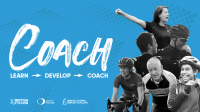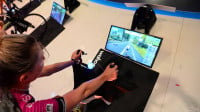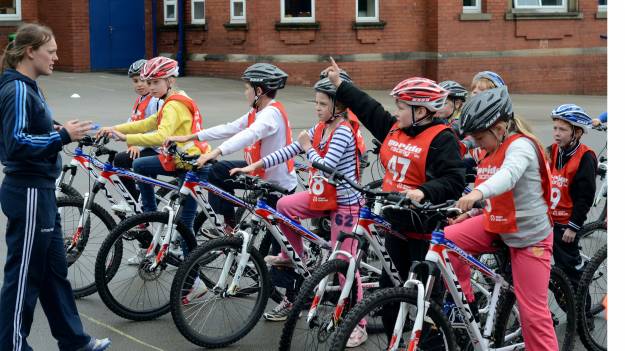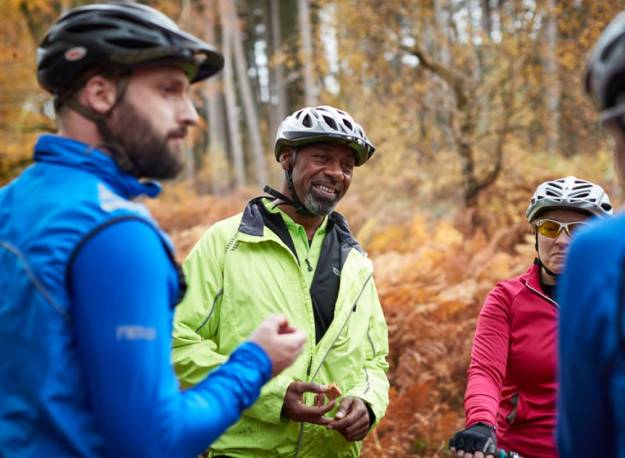Group Riding on the Track
March 2009
In this month's CPD article we will look at the techniques involved with riding the track as part of a group. Track coaching sessions and competitions rarely involve only one individual, so riders need to know how to ride in a group. Track sessions may involve up to 40 riders and individuals will find themselves leading, following or riding alongside other riders as well as passing and being passed by others on either side.
 Follow, Lead and Ride Side by Side
Follow, Lead and Ride Side by Side
One of the key elements to following, leading or riding alongside other riders is spatial awareness. This is the ability to judge distances, anticipate the movements of other riders, be aware of other riders and react to changes in the group. You can set down guidelines to help riders develop these skills and their riding abilities. Keep instructions simple and clear. Focus on key areas of a skill, one step at a time. This will help to speed up the learning process and avoid creating confusion among the riders. The following are some of the more basic points riders should be aware of when riding on a track as part of a group.
General coaching points for riding in a group:
- Make sure riders hold the drops of the handlebars, as this will improve riders' ability to control their bikes
- Emphasise that all changes in pace or direction need to be as smooth as possible
- Riders should keep their heads up and look where they are going
- Tell riders to avoid moving their bike excessively from side to side as this will waste energy and can be dangerous when riding in close proximity to other riders
- Riders should be aware that the bike can move backwards, relative to the following riders, as a rider stands up to ride out of the saddle
To lead correctly, riders should:
- Look where they are going
- Maintain the same line on the track
- Maintain a steady and constant speed
- Not make any sudden movements; changes in pace or direction should be gradual
- Look over their shoulder and communicate to the riders behind if they intend to move up or down the track
- Keep their heads up
- Stay relaxed
To follow correctly, riders should:
- Keep a comfortable distance from the rider in front - initially, this may be one to three bike lengths; with practice, this will be reduced to less than half a wheel
- Ride so they can just see over the out side shoulder of the rider in front
- Look where the front of the line is going and maintain a smooth, straight line
- Not over- or under-lap wheels
- Stay relaxed
- If a lead rider has a mechanical problem or fall, following riders should ride up the track and out of the way
- When a rider is riding in close proximity to the rider in front of them, it is their responsibility to ensure both riders' safety
To ride side by side correctly, riders should:
- Keep their heads up and look over the shoulders of the rider in front to anticipate any changes in pace or direction
- Stay relaxed
- Allow more space between riders if they are beginners
- Use their elbows to judge the proximity of an adjacent rider
- Maintain a constant speed
- Understand that outside riders will have to increase pace slightly on the banking
- Avoid half-wheeling other riders (ie when one rider rides half a wheel's length in front of another causing the second rider to increase their pace constantly)
- Communicate with other riders as necessary.
 Common Faults
Common Faults
It is essential that all group riding is done in a smooth fashion. Erratic riding creates gaps in the line and compromises safety, as riders accelerate and slow down to maintain their position. If the group's leader changes, the new leader often inadvertently speeds up, making the pace difficult for those behind. To avoid this, riders should focus on their pedaling cadence; they should aim to maintain the same rhythm and cadence when at the front of the group as when following.
Rather than mimicking every movement of the rider in front, following riders may need to smooth out the direction and pace of the line for their own benefit and for those behind them. The string of riders should be able to maintain a smooth line around the track.
Following riders often attend to the rear wheel of a leading rider when riding close behind, which can make it difficult to maintain a constant gap. Instead riders should focus on the seat post or saddle of the rider in front.
Top Coaching Tips
- Keep instructions simple
- Before setting the riders off, have the group feedback the activity and coaching points to check for understanding
- Put riders into groups before they set off and set each group off together
- Start with riders with reasonable gaps between them before they are instructed to ride closer
- Whilst giving instructions during an activity, ensure you are loud and clear so that all riders can understand what they need to do
Summary
Novice track riders, new to riding as part of a group, can be nervous of riding in close proximity to other riders. This can affect what they feel comfortable doing, the smoothness of their riding style and their ability to attend to the correct cues. Riders can be put at ease if they are clear on the activity and the relevant coaching points they must aware of. Ensure activities steadily build the difficulty of techniques required for group riding on the track and riders are challenged progressively. Time and practice will see most riders comfortably riding as part of a line within one or two sessions, and as part of a bigger group, within a few weeks of coaching. Above all, emphasise the importance of safe and considerate riding when riding as part of a group on the track.
The above article is based on information developed for the Level 2 certificate in coaching track cycling. To find out more information about the course please follow the links below or contact us at Coaching and Education on 0161 274 2060 .
Level 2 Certificate in Coaching Cycling
Level 3 Certificate in Coaching Cycling









